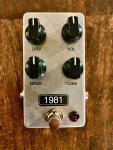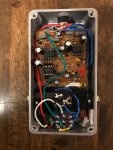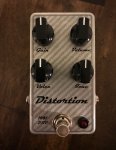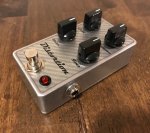Here's one I finished a few days ago. I don't normally post my vero builds here, but my understanding is that @PedalPCB gets credit for the trace they used on the tagboard site. Why did I go to the trouble to build it on vero instead of use the easy pcb here? I like to try to fit any pedal I can in a 1590B with side mounted jacks, it's just my preference.
Mods:
1. I used 100kB for the tone (cut) knob and I reversed the lugs so it acts like most pedals (turn the knob up for more highs).
2. Bass knob is a 10kC and 1uF cap to ground (wired in between the 470ohm resistor and 220n cap). This covers down to 278Hz when the knob is all the way up (470ohm and 1uF + 220nF). The Timmy and many others have the bass knob set up to cover frequencies all the way down to the bottom of the guitar range (about 80Hz or lower). I often try to target around 300-400Hz as I find this makes the knob more useable and less boomy (an idea I got from the Rockett Blue Note and Animal).
3. There's some little dip switches down by the footswitch to switch between red led clippers (on the main vero board) and 1n914s (tucked on a vero with the dip switches). I ended up setting it for 1n914s like the original.
Here's a podcast I found interviewing the designer (Matt Hoopes, who had a lot of help from the guy from Bondi Effects). It's not the most technically detailed content, but it's interesting to hear about some of the design choices. Also, it's super long. It's interesting to me personally since Emery (interviewer's band) has long been one of my favorite bands, and Relient K (builder's band) is a band I listened to in middle and high school. So it was fun for me to hear them talk about their different approaches to guitar and gear.
Mods:
1. I used 100kB for the tone (cut) knob and I reversed the lugs so it acts like most pedals (turn the knob up for more highs).
2. Bass knob is a 10kC and 1uF cap to ground (wired in between the 470ohm resistor and 220n cap). This covers down to 278Hz when the knob is all the way up (470ohm and 1uF + 220nF). The Timmy and many others have the bass knob set up to cover frequencies all the way down to the bottom of the guitar range (about 80Hz or lower). I often try to target around 300-400Hz as I find this makes the knob more useable and less boomy (an idea I got from the Rockett Blue Note and Animal).
3. There's some little dip switches down by the footswitch to switch between red led clippers (on the main vero board) and 1n914s (tucked on a vero with the dip switches). I ended up setting it for 1n914s like the original.
Here's a podcast I found interviewing the designer (Matt Hoopes, who had a lot of help from the guy from Bondi Effects). It's not the most technically detailed content, but it's interesting to hear about some of the design choices. Also, it's super long. It's interesting to me personally since Emery (interviewer's band) has long been one of my favorite bands, and Relient K (builder's band) is a band I listened to in middle and high school. So it was fun for me to hear them talk about their different approaches to guitar and gear.










